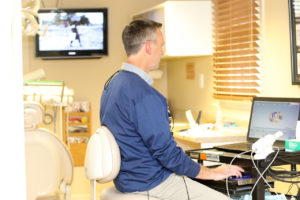WHAT’S IN YOUR MOUTH?
January 29, 2024
 Dentistry is full of old, new, and emerging technology. For example, the different ways to use dental implants over the last 30 years has been a major game changer in the field of dentistry. Likewise, CAD/CAM technology (computer-aided design and manufacturing of dental restorations) has seen steady growth over the same 30 years. Here is a little background on the some of the reasons this technology is here to stay.
Dentistry is full of old, new, and emerging technology. For example, the different ways to use dental implants over the last 30 years has been a major game changer in the field of dentistry. Likewise, CAD/CAM technology (computer-aided design and manufacturing of dental restorations) has seen steady growth over the same 30 years. Here is a little background on the some of the reasons this technology is here to stay.
Let me start by saying that the best dentistry is NO dentistry. Prevention of decay and other destructive things that happen to teeth is the best line of defense. Having said that, the fact of the matter is, there are many people who need things done to their teeth to preserve them for their lifetime.
Dental amalgam (silver filling) was introduced to dentistry well over 100 years ago. It proved to be one of the major contributors to saving many teeth that were in need of repair. Dental amalgam is a very hard material which can last for many years. However, there are many aspects of dental amalgam that are undesirable. It is ugly, tooth preparation needs to be more aggressive to retain it, the material breaks down over time, and it contains mercury. Dental amalgam is not used in most of Europe and has been dying a slow death in the United States over the last 30 years.
Progressive dentists, who were interested in providing better, longer-lasting dentistry, learned the skill of using gold. Despite the way you feel about gold in your mouth, done well, gold is still one of the best, most biocompatible and longest lasting materials used to protect teeth. Gold has also been dying a slow death mainly due to the fact that patients prefer tooth-colored restorations.
Then composite resin was introduced. It started as a filling material used to fill cavities on front teeth and eventually evolved enough to be used in back teeth. Dental composite, an ultraviolet light-cured resin, is the main direct restorative material used in dentistry today. It has become the amalgam replacement. It is relatively esthetic, chemically bonds to tooth structure, and allows for much more conservative tooth preparation. However, it is much softer than natural tooth structure and therefore has its limitations.
Dental amalgam and composite are what we in dentistry call direct restorative materials. This means that a cavity preparation is made and the material is directly placed in the tooth. This is different than gold or porcelain which are considered indirect materials. These are manufactured and then cemented or bonded to tooth structure.
When a tooth needs a larger filling, specifically one that needs to cover the cusp of a tooth due to fracture, risk of fracture due to cracks, or has undergone extensive destruction due to decay, direct materials like composite are not indicated due to wear factors. Indirect materials are more appropriate and are much longer lasting.
The advantage of CAD/CAM is the ability to provide stronger, esthetic, indirect materials in addition to being more conservative in tooth preparation. Next week I will continue this subject with the specific uses of this technology.
Dr. St. Clair maintains a private dental practice in Rowley dedicated to health-centered family dentistry. He has a special interest in treating snoring, sleep apnea and TMJ problems. If there are certain topics you would like to see written about or questions you have please email them to him at jpstclair@stclairdmd.com
IT’S YOUR CHOICE
January 22, 2024
 I attended a continuing education seminar entitled, “Making it Easy for Patients to Say Yes”. The name of the seminar is a bit deceiving. You might think that it was about how to “sell” people into dental treatment. It was quite the opposite.
I attended a continuing education seminar entitled, “Making it Easy for Patients to Say Yes”. The name of the seminar is a bit deceiving. You might think that it was about how to “sell” people into dental treatment. It was quite the opposite.
I am a firm believer in educating patients about their own dental health with the help of things like photography. I also think it is important to spend as much time as necessary to bring the patient’s dental I.Q. to a level that allows them to make more educated decisions about the degree of dental health they wish to achieve. Some people require more time than others, and some are not interested in the dialogue.
Although this seminar did confirm that educated patients make better decisions, it highlighted the fact that it is more important for the dentist to understand the patient, and where they are in their life. In order for this to happen, time is needed to build relationships with people.
This sounds pretty basic. However, the presenter of this seminar, who is a well-known figure in the dental world, felt that this relationship-based aspect of dental care is missing in most dental offices. Why? The cost to run a dental business, and many times the influence from insurance companies, creates the need to speed things up. Shortening the time the dentist/physician spends with the patient is a common goal in health care these days.
Most patients who require extensive dental treatment know that they have issues. They may not understand the extent of their issues, but they know things are not right. It is easy to move patients toward treatment if they have pain, or something is broken. However, patients who do not have pain or broken teeth may still have dental needs and require a different approach.
Before any educating is done, or before any treatment is discussed, it is vital for the dentist to understand more about the person behind the teeth. Sure, there are patients who come into an office and just want a tooth extracted, or know they need a root canal, but most people who go to the dentist have the desire to keep their teeth and be healthy. The fact of the matter is, even if the patient knows they need extensive work, they may not be in the right place in their lives to accomplish this goal.
There is no disputing that dentistry can be a significant investment, especially if you are in need of extensive work. Based on commercials I have seen, there are dental providers out there who make it seem like removing your teeth and replacing them with dental implants is the latest and greatest; you never have to worry about your teeth again! Buyer beware. This is typically not a good strategy, for many reasons. Sure, if all your teeth are non-salvageable, you can certainly use dental implants to help replace missing teeth. However, taking good teeth out because you think it will save you time and money at the dentist over your life is a false assumption. Health takes effort.
Do you rely on what dentist an insurance company says you can see, or what procedures are covered? Or do you believe that you are not only responsible for your own health, but you are also your own best advocate? The relationship you develop with a provider who takes the time to understand your specific situation, and you feel comfortable with, is in your best short and long-term interest.
The absolute key to better dental health is regular maintenance. It’s like what you hear for investing – start early and be consistent. The rewards for your dental health are gifts that keep on giving.
Dr. St. Clair maintains a private dental practice in Rowley dedicated to health-centered family dentistry. He has a special interest in treating snoring, sleep apnea and TMJ problems. If there are certain topics you would like to see written about or questions you have please email them to him at jpstclair@stclairdmd.com
SWEET TOOTH
January 17, 2024
 Dental caries (cavities, decay) is still very prevalent in today’s society. There are many factors that contribute to dental decay. In addition, there are some people who are more susceptible to decay than others. In a recent article in the Journal of the American Dental Association (JADA), sugar-sweetened beverages, one of the main culprits for dental decay, was discussed.
Dental caries (cavities, decay) is still very prevalent in today’s society. There are many factors that contribute to dental decay. In addition, there are some people who are more susceptible to decay than others. In a recent article in the Journal of the American Dental Association (JADA), sugar-sweetened beverages, one of the main culprits for dental decay, was discussed.
Dental decay is a multifactorial disease characterized as an infectious process during which carbohydrates are fermented by specific oral bacteria at the tooth surface. This results in acid production and enamel breakdown. It should be noted that the beverages described in this column are not the only things that lead to dental decay. Anything rich in carbohydrates or with high acidity can lead to decay. In addition, the right bacteria, genetics, insufficient home care, and salivary flow are all contributing factors.
With regard to beverages specifically, as described in the JADA article, the main carbohydrate additives to note are sugar, lactose, high-fructose corn syrup, sucrose, fructose, glucose, maltodextrin, and honey. The beverages to watch for containing these are milk – yes milk, flavored milk, 100 percent fruit juice and vegetable juice, soda, juice drinks, sports drinks, flavored water, flavored tea and coffee, energy drinks, smoothies, and nutritional supplements.
People usually consume multiple beverages daily. As I have described in past columns, one of the worst things you can do is to drink these kinds of beverages slowly throughout the day. Constant introduction of carbohydrates over a prolonged period feed bacteria and never allow the saliva to neutralize the oral environment. If you have decreased salivary production, this makes the situation much worse.
Here is a list of recommendations as stated in the JADA article:
- Consume these types of beverages at meals only
- Limit these types of beverages to once per day and to 12 ounces
- Consume these beverages within a 15-minute time frame
- Using a straw is preferable
- Replace these sugary beverages with artificially sweetened or unsweetened beverages. ** I would add to that preferably non-carbonated
- Brush teeth with fluoridated toothpaste 20 minutes after intake
- Chew sugar free gum immediately after intake
- Rinse mouth with water immediately after intake
Dental decay is preventable. Following the guidelines above, and practicing good oral hygiene can prevent the most common reasons for decay. It is important to note that most people have plenty of room for improvement with their oral hygiene. Brush your teeth right before your next dental appointment and then ask your hygienist or dentist to assess how well you are doing at plaque removal. You may be surprised at what you’re missing.
Dr. St. Clair maintains a private dental practice in Rowley dedicated to health-centered family dentistry. He has a special interest in treating snoring, sleep apnea and TMJ problems. If there are certain topics you would like to see written about or questions you have please email them to him at jpstclair@stclairdmd.com
OROFACIAL PAIN
January 8, 2024
 There are many people who suffer with pain involving some area of the head. Toothaches can cause pain, but these are mostly avoidable with proper diet, home care and regular visits to your dentist. Teeth can also play an indirect role in facial/head pain.
There are many people who suffer with pain involving some area of the head. Toothaches can cause pain, but these are mostly avoidable with proper diet, home care and regular visits to your dentist. Teeth can also play an indirect role in facial/head pain.
Orofacial pain includes a number of clinical problems involving the chewing (masticatory) muscles and/or temporomandibular joints (TMJs). Problems can include TMJ discomfort involving muscle spasms in the head, neck, shoulders and/or jaw, migraines or other types of tension headaches, pain with the teeth, face or jaw; and can even play a role in anxiety and/or depression.
You swallow approximately 2,000 times per day, which causes the upper and lower teeth to come together and push against the skull. People who have an unstable bite, missing teeth, or poorly aligned teeth can have trouble because the muscles work harder to bring the teeth together, causing strain. People with seemingly good teeth/bite are also susceptible. Pain can also be caused by clenching or grinding teeth, trauma to the head and neck, or poor ergonomics. Temporomandibular disorders (TMD) affect more than 10 million Americans. Your TMJ’s are located where the skull connects your lower jaw to the muscles on the sides of your head and face controlling the joint’s movements. Women between the ages of 20 and 40 are often more frequent sufferers because of the added estrogen in their bodies.
One in eight Americans suffers from headaches. Experts estimate that 80 percent of all headaches are caused by muscle tension, which may be related to the bite. Clenching the jaw muscles creates tension in the muscles that close the jaw, the main one of which is the temporalis muscle. Signs that may indicate a headache from dental origin include: pain behind the eyes, sore jaw muscles or “tired” muscles upon awaking, teeth grinding, clicking or popping of the jaw joints, head and/or scalp is painful to the touch, earaches or ringing, neck and/or shoulder pain, and dizziness. Keep in mind that in a 24-hour period of time, your teeth should only touch 10 minutes total. If you clench or grind your teeth, your teeth are touching much more than that and I can promise you that something in the masticatory system is being affected.
Sleep disorders can also play a role. I am not just talking about sleep apnea. There are a wide range of sleep disorders and some of them will cause people to clench and/or grind as a defense mechanism of the body to achieve proper air flow.
Dentists have a variety of ways to help relieve orofacial symptoms. One way to treat these problems is called an orthotic, or splint, that is worn over the teeth to help stabilize the bite; kind of like an orthotic some wear in their shoes for alignment and balance when standing. Permanent correction may require equilibration (reshaping teeth), prosthetic dentistry and/ or orthodontics. Many use a splint on a daily basis to avoid having these other treatments done.
Orofacial pain can range from tolerable to debilitating. Maintaining or correcting your bite ensures optimal health, and proper care will help reduce or eliminate orofacial pain or discomfort. If your dentist can not help you, ask for a referral.
Most important lesson of the day: The optimal rest position of the jaw (minus the 10 minutes the teeth touch in 24 hours) is lips together, teeth slightly apart, the tip of the tongue resting just behind your upper front teeth, and you should be breathing through your nose.
Dr. St. Clair maintains a private dental practice in Rowley dedicated to health-centered family dentistry. He has a special interest in treating snoring, sleep apnea and TMJ problems. If there are certain topics you would like to see written about or questions you have please email them to him at jpstclair@stclairdmd.com
MAKE IT STICK
January 2, 2024
Happy New Year! So, how does it feel being back at work? Or, if you are retired, does today feel like any other day? For many people, the New Year is time for resolutions. Gym memberships go up and so do sales of healthier food. I don’t know about you, but I have trouble sustaining many of my “resolutions”. Change is difficult.
During the time I had off this past week, I re-read a book I read a few years ago. It is called “The Slight Edge” by Jeff Olson. One of the main points in this book is that change or improvement in our lives comes one day at a time. It is the small decisions that we make daily, that we often consider insignificant, which mold who we are.
In a recent column on New Year’s resolutions in the Wall Street Journal the author says, “Typically, though, people fail to stick to their annual goals because the resolutions are too demanding, vague or unrealistic.” One of the strategies recommended is to predict in advance what the roadblocks will be and how you will manage them. In addition to that, I have found that a daily reflection of all the day’s events and the changes I would make will make for a better tomorrow.
Changing routines is probably one of the hardest things to do. However, changing routines is probably one of the most important things to do. Striving for improvement in our lives by changing our routine usually improves the quality of life.
Going to the dentist is a routine. It is not part of your daily routine but it should be part of your overall routine for staying healthy. One of the biggest challenges I see in the practice of dentistry is changing people’s routines. Changing my own routines is tough enough; how does someone motivate someone else to change their routine? I think legendary coach John Wooden sums it up best when asked how he was so successful motivating his players for so many years. He said it was his ability to get his players to do what they didn’t want to do in order to get the results they wanted.
When someone goes to a dentist with a problem and has not seen a dentist for one, five, ten, or twenty years, it is easy to “fix” the immediate problem. The thing that is not easy to do, for any dentist, is to get those people to come back – to change their routine. While it is the dentist’s job to “fix” the problem, it is also their job to motivate people to see the bigger picture. Some people can be motivated to do those things they don’t necessarily want to do to achieve their goal (health), and others cannot.
Our priorities dictate our routines. Priorities need change just as much as routines. If our priorities include health, we will spend money on a gym membership or home fitness equipment, go to the doctor or dentist on a regular basis, and eat things that are healthy. If hypertension could be controlled by regular exercise and/or medication, doesn’t that beat an early heart attack? If periodontal (gum) disease, which doesn’t hurt and 75% of the population has some form of, could be controlled by regular visits to the dentist, doesn’t that beat losing your teeth?
Changing your routine to improve your quality of life is worth every penny you may spend on it. As Jeff Olson says in his book, “You can’t change the past. You can change the future. The right choices you make today, compounded over time, will take you higher and higher up the success curve of this real-time movie called ‘your life’.” Best wishes for positive change in 2024!
Dr. St. Clair maintains a private dental practice in Rowley dedicated to health-centered family dentistry. He has a special interest in treating snoring, sleep apnea and TMJ problems. If there are certain topics you would like to see written about or questions you have please email them to him at 







